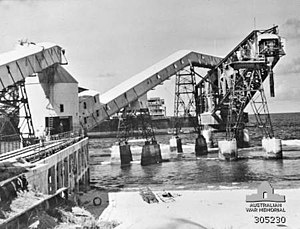
Back Německé útoky na Nauru Czech Angriff auf Nauru German Ataques alemanes a Nauru Spanish Attaques allemandes sur Nauru French הפשיטות הגרמניות על נאורו HE Attacchi tedeschi a Nauru Italian 독일의 나우루 공격 Korean Германские атаки Науру Russian
| German attacks on Nauru | |||||||
|---|---|---|---|---|---|---|---|
| Part of World War II | |||||||
 Damaged phosphate cantilever loading equipment following the German bombardment of Nauru on 27 December 1940 | |||||||
| |||||||
| Belligerents | |||||||
|
|
| ||||||
| Commanders and leaders | |||||||
|
| |||||||
| Strength | |||||||
|
2 auxiliary cruisers 1 supply ship | No military presence | ||||||
| Casualties and losses | |||||||
| None |
5 merchant ships sunk Damage to phosphate loading facilities | ||||||
The German attacks on Nauru were conducted in December 1940 on the island of Nauru, an Australian-administered League of Nations mandate in the Central Pacific. Nauru was of considerable strategic importance for its phosphate resources. The attacks were conducted by auxiliary cruisers between 6 and 8 December and on 27 December. The raiders sank five Allied merchant ships and inflicted serious damage on Nauru's economically important phosphate-loading facilities. Under the terms of the League of Nations mandate, the island had no fortifications or military facilities and was consequently undefended, with the German forces unimpeded in their operations.
The two attacks were the most effective operations conducted by German raiders in the Pacific Ocean in World War II. They disrupted supplies of phosphate to Australia, New Zealand and Japan, which reduced agricultural production in these countries. In response, Allied naval vessels were deployed to protect Nauru and nearby Ocean Island and escort shipping in the South Pacific. Small garrisons were also established to protect the two islands, but Nauru was ultimately evacuated of most non-indigenous residents following the attack on Pearl Harbor and was invaded by the Japanese in 1942.